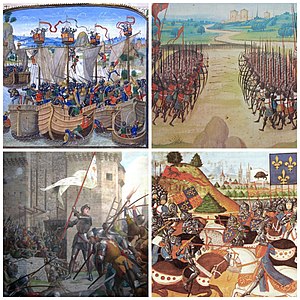| Hundred Years' War | |||||||||
|---|---|---|---|---|---|---|---|---|---|
| Part of the Crisis of the late Middle Ages and the Anglo-French Wars | |||||||||
 Clockwise, from top left: the Battle of La Rochelle, the Battle of Agincourt, the Battle of Patay, and Joan of Arc at the Siege of Orléans | |||||||||
| |||||||||
| Belligerents | |||||||||
| Kingdom of France loyal to the House of Valois |
| ||||||||
| Commanders and leaders | |||||||||
The Hundred Years' War (French: Guerre de Cent Ans; 1337–1453) was a conflict between the kingdoms of England and France and a civil war in France during the Late Middle Ages. It emerged from feudal disputes over the Duchy of Aquitaine and was triggered by a claim to the French throne made by Edward III of England. The war grew into a broader military, economic, and political struggle involving factions from across Western Europe, fuelled by emerging nationalism on both sides. The periodisation of the war typically charts it as taking place over 116 years. However, it was an intermittent conflict which was frequently interrupted by external factors, such as the Black Death, and several years of truces.
The Hundred Years' War was a significant conflict in the Middle Ages. During the war, five generations of kings from two rival dynasties fought for the throne of France, which was then the dominant kingdom in Western Europe. The war had a lasting effect on European history: both sides produced innovations in military technology and tactics, including professional standing armies and artillery, that permanently changed European warfare. Chivalry, which reached its height during the conflict, subsequently declined. Stronger national identities took root in both kingdoms, which became more centralized and gradually emerged as global powers.[1]
The term "Hundred Years' War" was adopted by later historians as a historiographical periodisation to encompass dynastically related conflicts, constructing the longest military conflict in European history.[2][3] The war is commonly divided into three phases separated by truces: the Edwardian War (1337–1360), the Caroline War (1369–1389), and the Lancastrian War (1415–1453). Each side drew many allies into the conflict, with English forces initially prevailing; however, the French forces under the House of Valois ultimately retained control over the Kingdom of France. The French and English monarchies thereafter remained separate, despite the monarchs of England (later Britain) styling themselves as sovereigns of France until 1802.
Cite error: There are <ref group=lower-alpha> tags or {{efn}} templates on this page, but the references will not show without a {{reflist|group=lower-alpha}} template or {{notelist}} template (see the help page).
- ^ Guizot, Francois (1997). The History of Civilization in Europe; translated by William Hazlitt 1846. Indiana, US: Liberty Fund. pp. 204, 205. ISBN 978-0-86597-837-9.
- ^ Rehman, Iskander (8 November 2023). Planning for Protraction: A Historically Informed Approach to Great-power War and Sino-US Competition (1 ed.). London: Routledge. p. 146. doi:10.4324/9781003464419. ISBN 978-1-003-46441-9.
The term 'Hundred Years War' was first employed by the French historian Chrysanthe-Ovide des Michels in his Tableau Chronologique de L'histoire du Moyen Âge. It was then imported into English historiography by the English historian Edward Freeman.
- ^ Minois, Georges (28 March 2024). La guerre de Cent Ans (in French). Place des éditeurs. ISBN 978-2-262-10723-9.